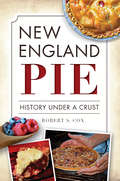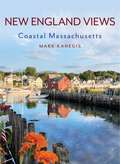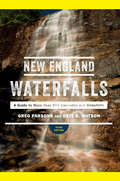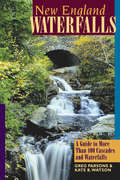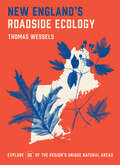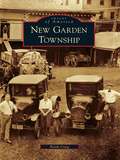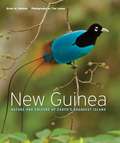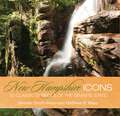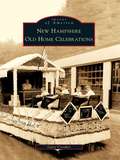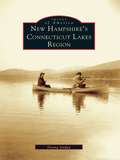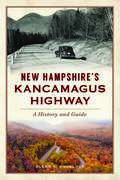- Table View
- List View
New England Pie: History Under a Crust (American Palate Ser.)
by Robert S. CoxPie has been a delectable centerpiece of Yankee tables since Europeans first landed on New England's shores in the seventeenth century. With a satisfying variety of savory and sweet, author Robert Cox takes a bite out of the history of pie and pie-making in the region. From the crackling topmost crust to the bottom layer, explore the origin and evolution of popular ingredients like the Revolutionary roots of the Boston cream. One month at a time, celebrate the seasonal fixings that fill New Englanders' favorite dessert from apple and cherry to pumpkin and squash. With interviews from local bakers, classic recipes and some modern twists on beloved standards, this mouthwatering history of New England pies offers something for every appetite.
New England Skiing (Images of America)
by E. John AllenSkiing in New England has not always been such a breathtaking sport connected with winter vacations at distant and local resorts. From the early 1870s, Norwegian, Swedish, and Finnish immigrants utilized skis to carry the mail and to travel through the woods to school and work. Later, a group of college men at Dartmouth founded the Outing Club, which transformed skiing from everyday practicality into swift-moving recreation. Since that time, the excitement and exhilaration of skiing has spread nationwide. In this volume, we will explore the history of skiing in this region, from its early, simpler days of cross-country and jumping to the rising popularity of alpine skiing beginning in the 1930s. Rather than a technical history, this book concentrates on presenting a story that is fluid like the sport itself, focusing on places, personalities, and major innovations between the early 1870s and 1940.
New England Views: Coastal Massachusetts
by Mark KanegisNew England Views: Coastal Massachusetts is a collection of stunning imagery that defines the characteristics of the region including the seascapes, landscapes, majestic lighthouses, cascading waterfalls, beaches, and harbors filled with fishing boats. The images are a colorful blend of people, places, and seasons that create a tapestry that is uniquely New England.
New England Waterfalls (Third Edition): A Guide To More Than 500 Cascades And Waterfalls
by Greg Parsons Kate B. WatsonHundreds of beautiful waterfalls and swimming holes across New England Lovers of all nature, Greg Parsons and Kate Watson are particularly fascinated with waterfalls. This new edition contains dozens of new waterfalls and provides extensive trail and road updates to existing ones. Waterfalls in every New England state are described according to type, height, trail length, and difficulty. Also included in this edition for the first time are color photographs, GPS coordinates for both the trailhead and the waterfall, and the size of the watershed area. With easy- to- follow maps and appendices of the best swimming holes and day trips, New England Waterfalls delivers a wealth of information for seekers of these regional treasures.
New England Waterfalls: A Guide to More Than 400 Cascades and Waterfalls (Second Edition)
by Greg Parsons Kate B. WatsonContains more than 400 waterfalls and many of the best swimming holes in New England. Whether hiking, fishing, skiing, or kayaking, Greg Parsons and Kate Watson have enjoyed experiencing water in all its various forms. But the form that has continuously fascinated them is the rarest and most beautiful one water can take: the waterfall. Full of allure and majesty, waterfalls are dramatic demonstrations of how the landscape changes over time. This greatly expanded edition describes more than 200 new waterfalls and provides extensive trail and road updates. Waterfalls throughout each of the New England states are described according to type, height, trail length and difficulty, water source, and the ideal seasons to visit. They are also rated for their inherent beauty so you can decide how best to spend your time. Chapters are organized by state, and each includes a map to help you easily identify other waterfalls nearby. With special appendixes of the best swimming holes, multi-waterfall day trips, and long-distance waterfall hikes, New England Waterfalls delivers a wealth of information for seekers of these regional treasures.
New England's Colonial Inns & Taverns: Centuries of Yankee Fare and Hospitality
by Maria OliaNew England&’s Colonial Inns and Taverns explores the history of these institutions and visits those that are still around. Today, there&’s no better remedy for the winter blues than a visit to a Colonial tavern. For centuries, travelers who have stepped out of the cold and into a tavern have found not only hearty Yankee fare, but also a feast for the senses: the warmth of a roaring fire, the creaking of uneven plank floors, the intoxicating incense of a smoky hearth and mulled apple cider, the taste of a cocktail chased by a swig of history. Centuries ago, taverns offered respites for weary wayfarers on horseback. Today, they remain welcome havens from high-speed lives.
New England's General Stores: Exploring an American Classic
by Ted ReinsteinExplore the fabric of America over hot coffee and penny candy. Step through the wooden doors of a New England general store and step back in time, into a Norman Rockwell painting and into the heart of America. New England&’s General Stores offers a nostalgic picture of this colonial staple and, fortunately, steadfast institution of small towns from Connecticut to Maine. This is where children of each generation take their first allowance to buy their very own penny candy. Locals have swapped stories at these counters from gossip to whispers of revolution. In tough times, the general store treated customers like family, extending credit when no one else would. Stubborn as New Englanders themselves, the general store has refused to become a mere sentimental relic of an earlier age.
New England's Notable Women: The Stories and Sites of Trailblazers and Achievers
by Patricia HarrisNew England has nurtured countless women who shook off traditional gender roles to forge their own destinies. Their achievements are legion. Narragansett tribal historian Princess Red Wing served as a delegate to the United Nations and co-founded Rhode Island&’s Tomaquag Museum. Boston iconoclast Isabella Stewart Gardner had the acute artistic vision to establish the museum that bears her name. Harriet Beecher Stowe ignited public opinion against slavery, arguably hastening the Civil War, as displays in her Hartford home make clear. Pioneering naturalist Rachel Carson jumpstarted the modern environmental movement with her writings about the rocky beaches and quivering tidepools of Southport, Maine. New England's Notable Women shines the spotlight on 45 of these trailblazers and achievers and directs readers to the homes and sites throughout New England where their stories come to life.
New England's Roadside Ecology: Explore 30 of the Region's Unique Natural Areas
by Tom WesselsStep Out of Your Car and Right into Nature!New England&’s Roadside Ecology guides you through 30 spectacular natural sites, all within an easy walk from the road. The sites include the forests, wetlands, alpines, dunes, and geologic ecosystems that make up New England. Author Tom Wessels is the perfect guide. Each entry starts with the brief description of the hike's level of difficulty—all are gentle to moderate and cover no more than two miles. Entries also include turn-by-turn directions and clear descriptions of the flora, fauna, and fungi you are likely to encounter along the way. New England&’s Roadside Ecology is a must-have guide for outdoor enthusiasts, hikers, and tourists in Connecticut, Maine, Massachusetts, New Hampshire, Rhode Island, and Vermont.
New Europe
by Michael PalinNo. 1 bestseller and superstar doing what he does best, introducing millions of avid readers to little-known peoples and places.Until the early 1990s, when the Berlin Wall came tumbling down, travelling behind the iron curtain was never easy. In undertaking his new journey through Eastern Europe, breathing in its rich history, and exquisite sights and talking to its diverse peoples, Michael fills what has been a void in his own experience and that of very many others. NEW EUROPE is very much a voyage of discovery, from the snows of the Julian Alps to the beauty of the Baltic sea, he finds himself in countries he'd barely heard of, many unfamiliar and mysterious, all with tragic histories and much brighter futures.During his 20-country adventure Palin meets Romanian lumberjacks, drives the 8.58 stopping train from Poznan to Wolsztyn, treads the catwalk at a Budapest fashion show, learns about mine-clearing in Bosnia and watches Turkish gents wrestling in olive oil. As with all his bestselling books, in his uniquely entertaining style, Palin opens up a new and undiscovered world to millions of readers.
New Europe
by Michael PalinNo. 1 bestseller and superstar doing what he does best, introducing millions of avid readers to little-known peoples and places.Until the early 1990s, when the Berlin Wall came tumbling down, travelling behind the iron curtain was never easy. In undertaking his new journey through Eastern Europe, breathing in its rich history, and exquisite sights and talking to its diverse peoples, Michael fills what has been a void in his own experience and that of very many others. NEW EUROPE is very much a voyage of discovery, from the snows of the Julian Alps to the beauty of the Baltic sea, he finds himself in countries he'd barely heard of, many unfamiliar and mysterious, all with tragic histories and much brighter futures.During his 20-country adventure Palin meets Romanian lumberjacks, drives the 8.58 stopping train from Poznan to Wolsztyn, treads the catwalk at a Budapest fashion show, learns about mine-clearing in Bosnia and watches Turkish gents wrestling in olive oil. As with all his bestselling books, in his uniquely entertaining style, Palin opens up a new and undiscovered world to millions of readers.
New Frontiers in Hospitality and Tourism Management in Africa (Tourism, Hospitality & Event Management)
by Ogechi Adeola Michael Z. Ngoasong Albert N. Kimbu Robert E. HinsonThis book provides a management perspective on the full historical, contemporary, and geographic landscape of hospitality and tourism (H&T) in Africa. In so doing, it critically assesses and challenges the applicability of Western theories within the African context and draws attention to the insights offered by African management concepts. A variety of key topics are examined, including, for example, H&T management practices and management innovation in Africa, the drivers of and variation in uptake of Western management practices, policies and strategies to promote the development of H&T organizations, the influence of management practices on the competitiveness of African countries as tourism destinations, and areas for improvement of H&T organizations in Africa in the digital age. The approach is multidisciplinary. Both local and global perspectives are presented by authors from Africa, Europe, North America, and Asia, with inclusion of intra- and inter-country comparisons. This book will be essential reading for scholars, students, businesses, and policy makers with an interest in H&T in Africa.
New Garden Township
by Keith CraigDuring its first 200 years, New Garden Township's settlers and citizens reaped the bounty of its natural resources. Granite veins within its the northern ridge, clay deposits under its southern plain, and waterpower coursing through its pitched hills surrounded a fertile central plateau. Toughkenamon, Kaolin, and Landenberg rose to industrial eminence while the village maintained its Quaker and agricultural influences. When the 20th century rendered the creek's mills, mines, and quarries obsolete, New Garden's population and promise shrank with its industry. Then mushroom farming bloomed, and Quaker ingenuity and immigrant ambition built a new, multimillion-dollar agricultural enterprise. New Garden Township provides a visual record of vintage photographs accompanied by archival research and narratives from lifelong residents to intimately depict the township's transformations through the generations.
New Glarus
by Kim D. TschudyNew Glarus was founded in 1845 by impoverished citizens of Glarus, Switzerland. Much of Europe was in the grips of a severe depression, food was in short supply, and jobs were equally scarce. In response to this crisis, the Swiss government formed the Swiss Emigration Society. The society offered passage to America for anyone who wanted to leave Switzerland. On April 16, 1845, a ship took 193 Swiss to the United States. Four months later, on August 16, these pioneers arrived in what would become New Glarus. The founding of this community might be one of the finest examples of the best of socialism. Each settler received 20 acres of land drawn through a lottery; land could not be exchanged for something better. The oxen teams needed to work the land were communally owned. The settlers looked out for the welfare of all, providing schooling, food, shelter, and health care.
New Gloucester (Images of America)
by Thomas P. Blake New Gloucester Historical SocietyNamed by the proprietors from Gloucester, Massachusetts, New Gloucester began as a frontier town, as it was the most inland settlement in Maine at the time. Incorporated in 1774, the town has been called home by such notables as mapmaker and author Moses Greenleaf, artist D. D. Coombs, original proprietor of the town of Foxcroft Joseph E. Foxcroft, traveling minister Ephraim Stinchfield, Abraham Lincoln's secretary of treasury William Pitt Fessenden, and abolitionist Samuel Fessenden. Shaker societies were set up in nine states, but the Sabbathday Lake Society, founded in 1783, is now the only active Shaker community remaining. With a long history of lumber mills and farms, New Gloucester is also home to Pineland Farms, the former site of the Maine Home for the Feeble-Minded, established in 1908, and now a renovated 19-building campus and 5,000-acre working farm.
New Guinea: Nature and Culture of Earth's Grandest Island
by Bruce M. Beehler Tim LamanAn enthralling exploration of the biologically richest island on Earth, featuring more than 200 spectacular color images by award-winning National Geographic photographer Tim LamanIn this beautiful book, Bruce Beehler, a renowned author and expert on New Guinea, and award-winning National Geographic photographer Tim Laman take the reader on an unforgettable journey through the natural and cultural wonders of the world's grandest island. Skillfully combining a wealth of information, a descriptive and story-filled narrative, and more than 200 stunning color photographs, the book unlocks New Guinea's remarkable secrets like never before.Lying between the Equator and Australia's north coast, and surrounded by the richest coral reefs on Earth, New Guinea is the world's largest, highest, and most environmentally complex tropical island—home to rainforests with showy rhododendrons, strange and colorful orchids, tree-kangaroos, spiny anteaters, ingenious bowerbirds, and spectacular birds of paradise. New Guinea is also home to more than a thousand traditional human societies, each with its own language and lifestyle, and many of these tribes still live in isolated villages and serve as stewards of the rainforests they inhabit.Accessible and authoritative, New Guinea provides a comprehensive introduction to the island's environment, animals, plants, and traditional rainforest cultures. Individual chapters cover the island's history of exploration; geology; climate and weather; biogeography; plantlife; insects, spiders, and other invertebrates; freshwater fishes; snakes, lizards, and frogs; birdlife; mammals; paleontology; paleoanthropology; cultural and linguistic diversity; surrounding islands and reefs; the pristine forest of the Foja Mountains; village life; and future sustainability.Complete with informative illustrations and a large, detailed map, New Guinea offers an enchanting account of the island's unequalled natural and cultural treasures.
New Hampshire Diners: Classic Granite State Eateries
by Larry CultreraNew Hampshire loves its classic diners. Porcelain-enameled and stainless steel facades dot the highways and collective memories of the state. They are the unofficial town halls where news great and small is discussed over a steaming cup of coffee. New Hampshire has lost many diners over the last five decades, but there are still plenty of vintage or retro-inspired eateries that serve up homey meals and local stories. Visit Roger's Redliner in Portsmouth and dig into a plate of hash browns, or stop in at the Red Arrow in Manchester and reminisce over the loss of the local Rainbow Vet's Diner. Diner historian Larry Cultrera brings more than thirty-three years of research and his own flavor of storytelling to this classic slice of Granite State cuisine.
New Hampshire Icons: 50 Classic Symbols of the Granite State (Icons)
by Matthew P. Mayo Jennifer Smith-MayoNew Hampshire literally has something for everyone: urban types looking for bookstores, coffee shops, swank eateries, and nightclubs; outdoorsy folks searching for endless vistas atop the high peaks of the White Mountains; history buffs seeking clues to the state&’s rich past; or snow-loving families hoping to schuss the slopes all day long. It is a place of quaint villages, swimming holes, general stores, and hillside farms. And its people, those singular Granite Staters, are the friendly caretakers who make sure it&’s there for all to enjoy.Profiled within these pages are fifty classic symbols of this extraordinary state, revealing little-known facts, longtime secrets, and historical legends. From frost heaves to Robert Frost, from Stonyfield Yogurt to the New Hampshire State House, New Hampshire Icons offers up the inside story on the Granite State.Did you know that New Hampshire has the shortest coastline of any state (18 miles)? That Mt. Washington is the official home of the world&’s worst weather? That pumpkins are the official state fruit? New Hampshire Icons features the people, places, events, foods, animals, and traditions that make it the singular state it is.
New Hampshire Off the Beaten Path®
by Stillman Rogers Barbara RogersTired of the same old tourist traps?Discover the Granite State with New Hampshire Off the Beaten Path®, inside you&’ll find: Destinations you never knew existed, from tucked-away hiking trails in Portsmouth to the best Cinnamon buns in New England at Green Acres General Store. Unique Experiences: take a ride up Mount Washington on the infamous cog railway or go deep sea fishing on the South Coast. Insider Knowledge on the best of the best from a local expert. Amanda Silva takes the guesswork out of planning your trip with her sharp roundup of all the best eateries, experiences, and essential spots you cannot miss. Practical information that goes beyond an internet search.Find out how to get there and get around by car, train, ship, or guided tours. Thorough overview of the State&’s famous residents, fairs, events, history, and culture. So, if you&’ve &‘been there, done that&’ one two many times, get off the main road and venture Off the Beaten Path®
New Hampshire Off the Beaten Path®: Discover Your Fun (Off the Beaten Path Series)
by Stillman Rogers Barbara RogersTired of the same old tourist traps? Whether you&’re a visitor or a local looking for something different, New Hampshire Off the Beaten Path shows you the Granite State you never knew existed. Follow a nature trail marked with verse at the Robert Frost Homestead.Taste authentic, open pit BBQ at the Yankee Smokehouse.Discover the history of skiing at the New England Ski Museum. So if you&’ve &“been there, done that&” one too many times, get off the main road and venture Off the Beaten Path.
New Hampshire Old Home Celebrations
by Gary CrookerIn 1899, when many New Hampshire residents were moving to cities and other parts of the nation, Frank Rollins, soon to become governor of New Hampshire, delivered a proposal to hold an annual event he dubbed Old Home Week. Similar in form to many of the family and town picnics already a tradition throughout New Hampshire, Old Home Week was designed as an open invitation to all the former residents of the Granite State to return to the homes of their youth. In addition to the ballgames, picnics, parades, and bonfires that were held during the third week of August, the celebrations resulted in municipal improvements across the state. Old homesteads were refurbished as summer homes, and libraries and monuments sprung up throughout the region as residents returned, creating a movement toward a renewed pride in the community.
New Hampshire on Skis (Images of Sports)
by E. John AllenThe state of New Hampshire has a strong skiing tradition to brag about, and in the 1930s, it led the United States in ski activity. The early prominence of Dartmouth College's Outing Club and winter carnival was a major forerunner in the development of the sport and readied the state to receive the alpine impetus coming from Europe in the 1930s. Germans and particularly Austrians-some fleeing Nazi persecution-brought with them the expert downhill schuss and found the White Mountains suitable terrain. Rail excursions from Boston, well-plowed roads, help from the Civilian Conservation Corps, and entrepreneurial activity helped skiing take off, and many ski centers boasting rope tows opened.New Hampshire on Skis follows this development and the rise in popularity of skiing in the state. Such innovations as the Cannon Tram, operating from 1938, marked a high point of state-supported ski promotion. After World War II ended, development of ski areas began in earnest. In the late twentieth century and today, ski areas have combined their ski sport activity with other snow sports-snowboarding in particular. New Hampshire on Skis documents the growth of the ski industry in New Hampshire from its European beginnings to what is now one of the most popular winter destinations on the East Coast.
New Hampshire's Connecticut Lakes Region
by Donna JordanThe Connecticut Lakes region is the last great frontier of the North Country. Forming the extreme northern tip of the state, it offers the only port of entry from Canada into New Hampshire. It includes Pittsburg, the most sizable township in the country-three hundred thousand acres in all-and the beautiful and wild Connecticut Lakes. Its fascinating history glistens in the two-hundred-plus images of New Hampshire's Connecticut Lakes Region. Pictured are rich logging lands, a mecca for sportsmen for more than a hundred years, and waterfront camps, cabins, and lodges. From 1832 to 1836, Pittsburg was known as the Indian Stream Republic, maintaining independence from both the United States and Canada.
New Hampshire's Cornish Colony
by Fern K. Meyers James B. AtkinsonNew Hampshire's Cornish Colony illustrates this distinguished American art colony. First settled in 1885 by colleagues of America's Michelangelo, Augustus Saint-Gaudens, the Cornish Colony was a retreat for sculptors, painters, writers, and musicians. They were attracted to this peaceful valley nestled in the New Hampshire hills in the shadow of Vermont's Mount Ascutney. Known as "the Athens of America," the Cornish Colony was a lively, glamorous society during its heyday from 1885 to 1925. One outstanding member, the famous artist Maxfield Parrish, was called a "chickadee" because he spent the entire year in Cornish, not merely the summer. In New Hampshire's Cornish Colony, discover a portrait of the colonists' society and the fascinating people who contributed to America's cultural legacy.
New Hampshire's Kancamagus Highway: A History and Guide (History & Guide)
by Glenn A. KnoblockConsidered to be one of the most scenic roads in America, the Kancamagus Highway draws thousands of tourists to New Hampshire annually. The highway, which runs between Conway and Lincoln and through the towns of Albany and Waterville Valley, was fully opened in 1967, but the development of the highway itself took over 120 years to become a reality. The Kancamagus is the gateway to the southern White Mountains and such celebrated natural sites as Sabbaday Falls, Lower Falls, and Rocky Gorge, to name just a few. Join historian and author Glenn Knoblock as he details the development of this Granite State treasure, and offers a comprehensive guide to all there is to see and do along the "Kanc".
